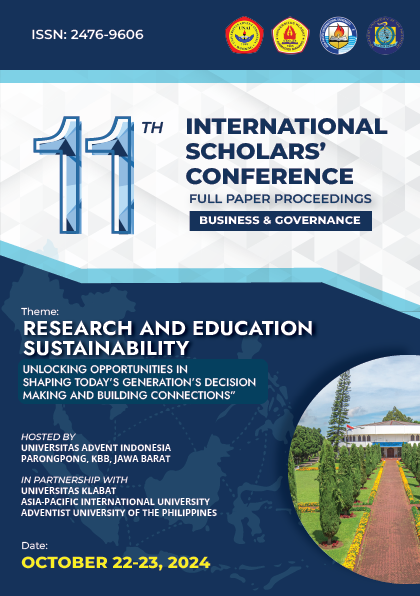A Case Study on Financial Management Among Indigenous Beneficiaries of The Pantawid Pamilyang Pilipino Program
Keywords:
Pantawid Pamilyang Pilipino Program, Financial Management, Indigenous BeneficiariesAbstract
This research documents the case of financial management Indigenous People (IP) Beneficiaries of the Pantawid Pamilyang Pilipino Program (4Ps) in Brgy. Pag-asa Mlang North Cotabato. This study utilized a case study design. Utilizing the Case Study Design for Qualitative Research, this study aimed to investigate the abstract financial management practices of 4Ps IP Beneficiaries in Barangay Pag-asa, Malang, North Cotabato. It sought to understand financial management by analyzing financial behaviors, budgeting tactics, and saving habits. The Indigenous Peoples (IP Community is one of the beneficiaries of the 4Ps, a conditional cash transfer program which aims to reduce poverty and improve living conditions in underprivileged areas of the Philippines. Using in-depth interviews and participant observation, findings reveal that while 4Ps provide crucial financial aid, beneficiaries often struggle with financial planning due to low financial literacy and unexpected expenses. Cultural and community dynamics significantly influence their financial decisions. The findings highlight the need for targeted interventions to enhance financial literacy, improve access to financial services, and support sustainable income generation among 4Ps beneficiaries. It likewise contributes to a better understanding of the financial management practices of Indigenous communities in the Philippines, particularly those participating in the 4Ps program.
Downloads
References
Alagar, N. P., & Ali, A. (2017). Financial literacy among indigenous people: A case study of the Orang Asli in Malaysia. International Journal of Social Economics, 44(6), 811-825.
Arias, A. (2017). The Indigenous Peoples and their Right to Financial Services. In Indigenous Peoples' Rights in the Globalized Castillo Economy (pp. 103-128). Routledge.
Asis, R. D. (2017). Indigenous Peoples and Financial Management in Rural Philippines. Philippine Journal of Indigenous Studies.
Carino, A., De Rosa, S., Sorrentino, S., Polimeni, A., Sabatino, J., Caiazzo, G., ... & Indolfi, C. (2016). Modulation of circulating microRNA levels during the switch from clopidogrel to ticagrelor. BioMed research international, 2016.
Chakraborty, S. (2013). Financial management practices of indigenous communities: A case study of the Santhal tribe in India. Journal of Rural Development, 32(1), 1-14.
Demirgüç-Kunt, A., & Klapper, L. (2012). Financial inclusion and economic development: A review of the literature. Journal of Financial Intermediation, 21(3), 319-343.
Department of Social Welfare and Development (2022). Pantawid Pamilyang Pilipino Program (4Ps). Retrieved from https://www.dswd.gov.ph/4ps/
Department of Social Welfare and Development. (2023). Pantawid Pamilyang Pilipino Program (4Ps) Annual Report. Manila: DSWD.
Fernandez, L., & Olfindo, R. (2011). Overview of the Philippines’ Conditional Cash Transfer Program: The Pantawid Pamilyang Pilipino Program (Pantawid Pamilya). Philippine social protection note, 2.
Gitman, L. J., & Zutter, M. J. (2017). Principles of managerial finance (15th ed.). Pearson Education.
Indigenous Community Development Finance: A Practical Guide (2022). Indigenous Community Development Finance.
Jackson, R. (2018). Prioritizing Essential Needs in Financial Management for Indigenous Populations. Indigenous Economics Journal.
Johnson, M., & Asis, R. D. (2017). Financial Practices of Indigenous Beneficiaries of the 4Ps Program in Rural Philippines. Philippine Economic Review.
Lusardi, A., & Mitchell, O. S. (2014). Financial literacy: Skills, knowledge, and outcomes. Oxford University Press.
Mendoza, M. C., & Saligan, B. M. (2019). Financial Literacy and Financial Inclusion: A Comparative Study of Indigenous and Non-Indigenous Farmers in the Philippines. Journal of Development and Agricultural Economics, 11(1), 1-17.
Montilla, M. M., Delavin, E. A., Villanueva, R. M., & Turco, R. A. (2015). Pantawid pamilyang Pilipino program (4Ps): Assistance to pupil’s education. Asia Pacific Journal of Education, Arts, and Sciences, 2 (3), 1(5).
National Economic and Development Authority (NEDA). (2020). Evaluation of the Pantawid Pamilyang Pilipino Program (4Ps). NEDA.
Noe, R. A., Hollenbeck, J. R., Gerhart, B., & Wright, P. M. (2017). Human resource management: Gaining a competitive advantage
Orbeta, A. C., & Paqueo, V. B. (2016). Pantawid Pamilya Pilipino Program: Boon or Bane? (No. 2016-56). PIDS Discussion Paper Series.
Panganiban, A. D. (2020). Indigenous Peoples' Perspectives on Financial Literacy and Inclusion in the Philippines. The Philippine Economic Journal, 40(2), 1-28.
Schady, N. R. (2020). Cash Transfers and Financial Management: The Case of Conditional Cash Transfers in Low-Income Households. Journal of Economic Development.
Senn, L. A., & Kearney, M. (2015). Financial literacy and financial well-being: A review of the literature. Journal of Financial Counseling and Planning, 26(2), 1-12.
Smith, L. T. (2012). Decolonizing methodologies: Research and indigenous peoples. Qualitative Research, 12(1), 9-25.
World Development Report 2000/2001: Attacking Poverty. Oxford University Press.
Yin, R. K. (2018). Case Study Research and Applications: Design and Methods. Sage Publications.
Downloads
Published
How to Cite
Issue
Section
License
Copyright (c) 2024 11th International Scholars Conference

This work is licensed under a Creative Commons Attribution-ShareAlike 4.0 International License.
Copyright © 2024 ISC Committee.















